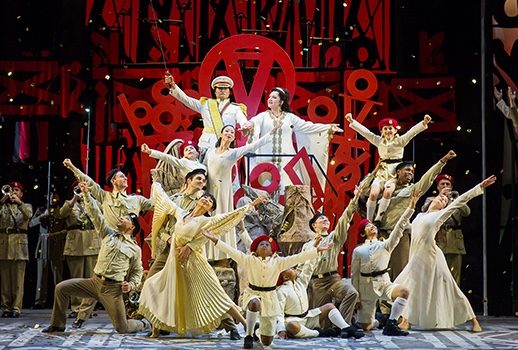
I see flags, I hear bells, there’s a parade in Memphis. Photo: Scott Suchman
The reasoning behind putting on Aida over any other Verdi opera must be that if you put ancient Egypt onstage, sooner or later you’ll find Tutankhamen’s tomb. It has name recognition value and is a surefire box office reward, but now carries a promise of luxury and extravagance onstage that other operas allegedly don’t have. (Evidence: the man behind be who, before the performance started, asked “Is this the opera about the elephant?”)
But Aida certainly has its longueurs, it’s no more poignant or universal in its messages than any of Giuseppe Verdi’s other middle period or mature works, and he certainly wrote more interesting characters. So, how do you pry Aida away from its Aïda-ness, especially if that Aida-ness is untenable? WNO provides, if not an inconsistent one, an answer.
In a well-contrasting pair of casts and an aesthetically-driven production that counts as one of the more successful by American opera’s most prominent jack (jill?) of all trades, Francesca Zambello, WNO opened its season on Saturday with a new-to-DC production of Verdi’s sandiest opera previously seen in San Francisco last fall with 2016 Richard Tucker Music Foundation award winner Tamara Wilson headlining as the titular “prisoner” (as the dreadful, sanitized translations would have it.)
In her first DC Aidas, Wilson brings her characteristic sharp-edged voice and delicacy of attack to a part she’s sung for several years. She sings the role, including both her arias, with visible introspection, thoughtful phrasing and dynamic, and gorgeously floated high notes, and she’s an earnest, if exclusively gloomy in this role, actress.
But her ample voice promises further rewards. Her excursions into heavier Verdi and Strauss have been well-received and she’ll take on Sieglinde under Gergiev in Paris next year. It’s a career to watch, but we knew that already. This milestone stands as an interesting counterpoint to Leah Crocetto’s highly communicative and more varied reading seen the following day.
Though Crocetto was more physically engaged onstage and the role gives opportunity to showcase her vocal thrust and dramatic urgency, especially in the two emotionally wrought arias, I got the impression that there wasn’t much more to see. We’ll see more of her vocal arsenal when she returns in the spring for Don Carlo, but if Wilson is going to titillate DC audiences with the promise of more and then not give it to them, then Crocetto ought to get a gimmick.
The pair of Radami each presented their own strengths and limitations. Wilson’s Radames, Yonghoon Lee, totes a large, forceful voice, but has grown staid as an actor, lost in squillo since my last hearing, and become increasingly mannered. During “Celeste Aida,” he’d scoop up to every phrase-ending f-note, the tone would go dull, and the vowel would completely flatten.
Not too different was Carl Tanner’s capable but leathery-sounding Radames on the second night. What’s worse, though, was that he blustered his way through the part looking like a dead-ringer for Mussolini in Anita Yavich’s almost uniformly unflattering costumes.
The Aidas found themselves well contrasted at every turn by their Amnerises, though. Ekaterina Semenchuk’s woolier voice stood in stark contrast to Wilson’s, though she declaimed practically the whole role and disappointingly appeared less engaged in every aspect than she does in her most recent turn in the role opposite Netrebko in Salzburg.
But while Semenchuk was mere petulance, Sunday’s Marina Prudenskaya was pure decadence and cruelty tethered to a true emotional arc. Prudenskaya’s distant, seductively dark voice and superior, slinky bearing onstage complemented Crocetto’s do-gooder Aida, and her relentless conviction elevated her every scene.
In the smaller parts, Morris Robinson was neither intelligible nor stylish as Ramfis, Gordon Hawkins cajoled with a sound more burnished than weathered as Amonasro, and Soloman Howard was authoritative and incisive as the King. In the pit, Evan Rogister consistently struck a balance between communicating the characteristic sweep of the score, maintaining propulsive tempi, and drawing some luxurious playing from the WNO Orchestra in conjunction with the WNO Chorus.
In an inspired move, Zambello drew in collaborating artists outside of opera and the results are mostly impressive. The calligraphic production designs, inspired by street artist Retna, are vaguely suggestive of a north-African locale and graciously frame Mark McCollough’s sensuous lighting and Michael Yeargan’s utilitarian sets. Jessica Lang’s thoughtful choreography (especially for the children) makes every one of the ballets just that.
Only the costumes, military uniforms for the men and racks of tie-dye caftans for the women, fall flat. And though the production, boasting over 100 people onstage, sometimes suffers from traffic control problems, Zambello is more hands-off on the storytelling of the piece than usual and the singers’ experience shines through as a consequence.
I’m not sure if my neighbor who started the afternoon in search of ivory was pleased with what he came back with, but the weekend yielded an earnest and thoughtfully considered reevaluation of Aida that didn’t sell it for spectacle and took every opportunity to be meaningfully provocative. And after two performances of Aida in 24 hours, I count that as a ritorno vincitor.





Comments